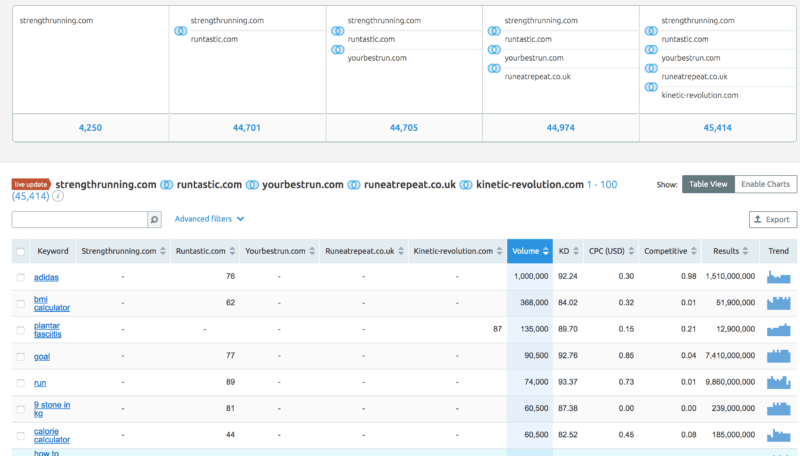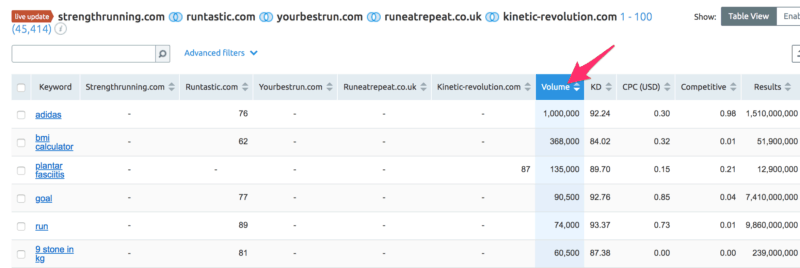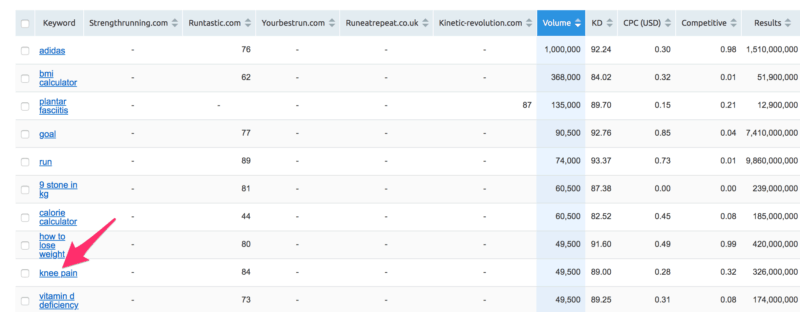Last updated on 6th November 2024 at 17:31 by Alex Nicholas
There are a number of ways to stay ahead of your competitors, and by studying and comparing the gaps in your content in comparison to your competitors, you can quickly become the most valuable authority Website in your niche.
When we start new projects, launch new products or indeed take over or buy Websites, we’re able to write endless amounts of content on topics surrounding our site and are constantly thinking of new areas to cover. However, there almost always comes a time when we run out of ideas because we assume we’ve covered everything there is to discuss, but this simply isn’t true. So in this article, you’ll find out how as a link building company we quickly come up with new ideas by using SEMRush’s keyword gap tool.
By following my process you’ll not only give yourself fresh ideas but also learn how to quickly and easily understand just how well your competitors are or aren’t performing in the SERPS.
But first…
What is a content gap analysis and why do we need it?
Content gaps are exactly what the term sounds like, gaps in your Website content that are effectively missed opportunities by either you and/or your competitors that should be filled so that you attract more visitors to your site and create clusters of topics surrounding important keyword phrases, products, or events that you want to be known for and will generate revenue.
You’re effectively looking to the future to make sure your topics are covered by finding out how potential customers are searching and aiming to be a part of their journey, whilst getting a basic understanding of the Website traffic levels your competitors receive.
But ultimately it comes down to one key thing that makes gap analysis utterly critical, how can I drive more visitors to my Website?
So head over to SEMRush and follow along as I guide you away from the nightmare that is the I can’t think of anything else to write about brain block.
Step #1
Open up Keyword Gap, select the country you’re interested in and enter the domains you want to analyse, starting with your own domain.

As you can see from this image, the tool allows you to compare up to 5 domains along with letting you choose whether you want to study organic keywords, paid keywords, or PLA keywords (Google shopping), but seeing as this is an SEO article we’re obviously going to be using organic keywords.
You’ll also notice that I’ve highlighted the 2 circles, and this is because these need to be clicked. This is the ‘All Keywords‘ button which means you get to see all of the ‘common keywords’, ‘unique keywords’, and ‘unique to 1st domain’s keywords’. So that after you’ve entered the domains you want to analyse you must make sure that you click on the ‘All Keywords’ circles then press go, and you’ll be presented with a mass of information.
Step #3

As you can see, after you’ve hit go you’ll be presented with a long list of information that might look a little meaningless, to begin with, however, it’s far from meaningless (obviously). In fact, this is where you start to see a clear picture of where your competitors are with their number of ranking keywords in comparison to you.
So let’s look a little deeper into what exactly you’ll see here so you can start navigating your way to covering your topic with more depth and breadth.
Step #3
Firstly, you can see that on it’s own strength running has 4250 keywords it’s ranking for on it’s own. Next to this, you have the combined total of keywords both strength running and runtastic rank for which is 44701, and so on until the keywords of all 5 domains are combined to give you the total number of ranking keywords, which in this case is 45414.
Secondly, you need to click on the ‘volume’ button (probably 3 times) to change the search volume to go from highest to lowest and look at what keywords your competitors are ranking for, especially study those keywords that have a high number of monthly searches that your competitors aren’t showing up for.

Thirdly, look through the results carefully to see exactly what your competitors are being found for.

What you’ll see here as you scroll through the results are opportunities to beat your competitors because they either aren’t ranking at all, or they aren’t ranking very highly.
For example, when I look at the above results I can see that there’s an opportunity to gain very good traffic by dedicating a page to ‘knee pain’.
Now don’t get me wrong, everything must be taken in context and what the person conducting the search is actually looking for, but remember that Google is smart and will be watching your searches (as well as the backlinks built by your competitors), so they’ll understand that someone who likes running and then uses the search term knee pain will be searching because it’s affecting their running so will likely return search results based around how to deal with knee pain in runners.
Step #4
What I like to do next is set up some filters because, at the end of the day, we do need to be realistic with the keywords/phrases we choose to write about, and this will all come down to how confident you are in your own abilities as an SEO. For example, you might decide that a keyword difficulty of 50 and above might be too much effort for not much return so you might want to set the keyword difficulty to 1-25.
Similarly, with actual search volume itself, you might (often correctly) assume that the competition for massive volume keywords will be dominated by large organisations with massive SEO budgets so your best bet might be to limit the number of monthly searches to 50-5000.
There’s also a very helpful feature that allows you to filter the results down to keywords that you’ve selected. In this running example you might decide to filter the results down to those that contain the phrase 5k or 5k PB (personal best) to see if your competitors have considered this phrase and if so, how are they doing in the SERPs.
A word of caution before embarking on writing new content
I must point out (as touched on above) that before you set about writing your new articles you must try to understand the user intent surrounding the query you intend to write about, so I suggest you perform these checks before you start:
- Is the content going to be evergreen? It should be in today’s world of SEO because it does perform better in the SERPS
- Study the SERPs themselves. When you enter your chosen phrases into Google what does it return? Are they showing you articles or is it top-heavy with YouTube videos? This is important because you must create content that replicates what Google is showing you. This is purely based on Google figuring out what people actually want when they perform a search and giving it to them.
- Is the query commercial? By that I mean is Google loading above-the-fold screen space with things like shopping ads? If it is then this is based on the fact that Google knows that people are generally looking to buy something when they perform this search, so an informational article might not get much traffic.
What people (including SEOs) so often don’t take into account is what Google is telling them without saying anything at all, namely what’s right in front of them in the SERPs. So perform your searches, look at what’s in front of you and either follow that guide or move on to the next search phrase.
Summing up
As you can see by using SEMRush to conduct your content gap analysis you’re instantly gaining an advantage because of the data and insight the software provides, but remember, the reason you’re conducting the analysis is to gain more customers by plugging holes in your own content, it’s not simply used to spy on your competitors. But be clever about it and don’t just create content for the sake of it, look at what people are actually wanting and follow that lead.
By going through this process a few times you’ll quickly start understanding your customers’ pain points and what you must do to combat them and put your brand in front of them. And by doing this you become a recognised source for your customers and for Google.